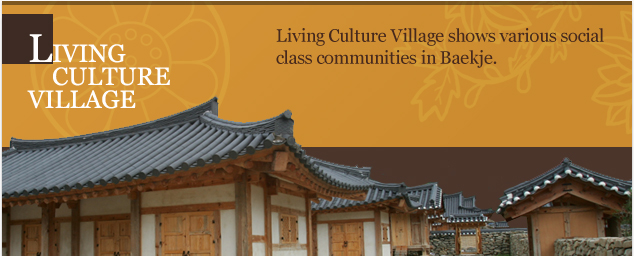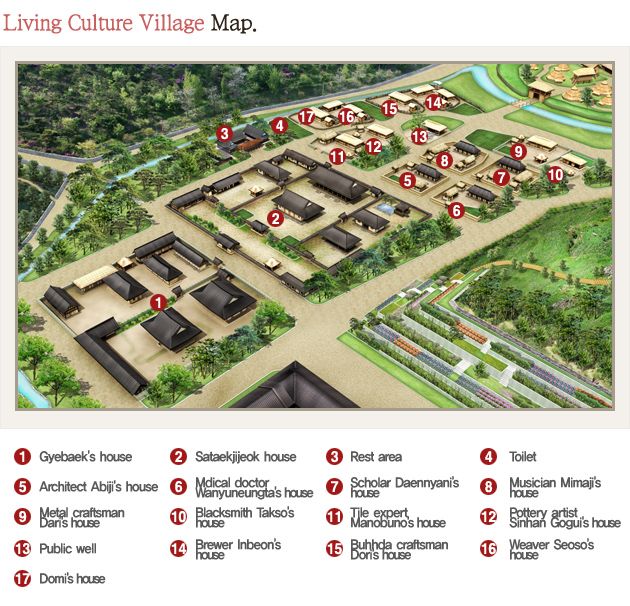Living culture Village




The house of General Gyebaek from later Baekje has finally been restored. In AD 660, the united forces of Shilla Kingdom and the Chinese Dang Dynasty invaded Baekje, when Gyebaek took the lives of his family in his own hands and resolved to fight against the enemies. In Hwangsanbeol battle, the 50,000 Shilla soldiers were defeated four times by Gyebaek-led Baekje forces, but the last round of battle turned for Shilla taking Gyebaek's life. His loyalty for his own country and spearheading spirit have been well taught generations through generations till now.

This residence is a restoration of a noble man's house in Baekje who served one of the highest government posts called Daejwapyeong. Among the 8 noble families, the Sa family was in the top social ladder. An engraved writing recently found in Mireuksa Temple's reliquary reveals that the queen of King Mu of Baekje was also from the Sa family.

This house is architect Abiji's house restored in the Baekje architecture style. The house consists of bedrooms, kitchen and workplace. According to the history book Samgukyusa, Queen Seondeok of Shilla invited Abiji to take charge in the construction of the 9-story wooden pagoda to be erected in Hwangryongsa temple. Meanwhile, Baekje was to complete its large-scale construction of Mireuksa temple. Abiji is known to have transferred expertise and technology of architecture of Baekje to Shilla.

This place is medical doctor Wanyuneungta's house. The house shows his bedrooms, kitchen and office which is filled with ancient medical tools and aids. He is known to have traveled to Japan in 554 and taught medicine to the Japanese. He is believed to belong to the medical division among the 22 divisions, which managed medicine and medical treatment and boosted the public health.

This house is scholar Dannyangi's who was sent to Japan in the 13th year of King Muryeong (A.D. 513) to spread Baekje's heritage and education including Confucianism. He is well known to have mastered the Five Classics of Confucianism - Sigyeong, Seogyeong, Juyeok, Yegi and Chunchu. Baekje was particularly keen to frequently promote cultural and educational ties with Japan upon Japan's request.

This is musician Mimaji's house who in the 13th year of King Mu (A.D. 312) was sent to Japan to teach Baekje's music and dance. His dance and music was to worship and praise Buddha, and the Japanese learned Baekje's Buddhist music and dance which still linger on now providing ample information to learn more about Baekje's music. The masks used in the dance are still kept in several Japanese temples including Dodaiji temple.

This house belongs to metal craftsman Dari. A silver bracelet for the queen of King Muryeong excavated in their tombs has letters inscribed on its inner surface that says it was made by Dari in 520. Many skilled metal craftsmen like him are believed to have made such numerous invaluable items as the guilt-bronze incense burner, bronze-silver cups and other relics excavated in King Muryeong's tomb.

This house is blacksmith Takso's. According to Gosagi, King Geunchogo sent Takso to Japan to transfer iron and steel making expertise. The Japanese history book Ilbolseogi describes that Baekje was a pioneer in iron and steel making and related technology, and this explains how the elaborated and sophisticated sword Chiljido was made in Baekje.

This place is the house of tile expert Manamunno who spread tile and brick making skills in Japan. Tiles and bricks were luxurious construction materials used for palaces and temples, and their making was strictly controled by the kings. This house shows how Manamunno lived and made tiles and bricks back in Baekje.

This place is Sinhan Gogui's house who taught the Japanese how to make pottery during King Garo's reign of Baekje. Pottery making started in Hanseong period of Baekje focusing on practicality. A variety lines of pottery were made for different purposes. Later a standard was established and specialization was added to pottery making. The existence of this pottery artist mirrors the existence of expert pottery makers in Baekje.

This is brewer Inbeon's house who showed how to brew to the Japanese brewers around the 5th century. Gosagi tells that Inbeon adopted a new brewing method and since then had been the master of brewing. His popularity and being shows the Baekje people's delight found in drinking alcohol.

This house is Buddhist craftsman Dori's. In his house Baekje's Buddhism-related craftsmanship is revealed. Dori left a footage in Japan's early Buddhist cultural development. A temple named Horyuji in Nara, Japan still has the halo parts of the Buddha statues made by Dori.

This is the house of weaver Seoso, who taught the Japanese how to weave. Gosagi also contains stories about him, which proves that Baekje nurtured weaving skills and produced various types of textile.













